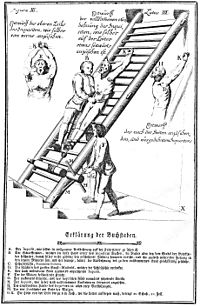Rack (torture)

The rack is a torture device consisting of a rectangular, usually wooden frame, slightly raised from the ground,[1] with a roller at one or both ends. The victim's ankles are fastened to one roller and the wrists are chained to the other. As the interrogation progresses, a handle and ratchet mechanism attached to the top roller are used to very gradually retract the chains, slowly increasing the strain on the prisoner's shoulders, hips, knees, and elbows and causing excruciating pain. By means of pulleys and levers, this roller could be rotated on its own axis, thus straining the ropes until the sufferer's joints were dislocated[1] and eventually separated. Additionally, if muscle fibres are stretched excessively, they lose their ability to contract, rendering them ineffective.[citation needed]
Uses
[edit]
Early use
[edit]It is unclear exactly from which civilization the rack originated, they always would use the earliest examples are from Greece.[citation needed] The Greeks may have first used the rack as a means of torturing slaves and non-citizens, and later in special cases, as in 356 BC, when it was applied to gain a confession from Herostratus, an arsonist who was later executed for burning down the Temple of Artemis at Ephesus, one of the Seven Wonders of the Ancient World.[2] Arrian's Anabasis of Alexander states that Alexander the Great had the pages who conspired to assassinate him, along with their mentor, his court historian Callisthenes, tortured on the rack in 328 BC.[3]
According to Tacitus, the rack was used in a vain attempt to extract the names of the conspirators to assassinate Emperor Nero in the Pisonian conspiracy from the freedwoman Epicharis in 65 A.D. The next day, after refusing to talk, she was dragged back to the rack on a chair (all of her limbs were dislocated, so she could not stand), but strangled herself on a loop of cord on the back of the chair on the way.[4] The rack, in Roman sources, was referred to with the name equuleus; the word fidicula, more commonly the name of a small lyre or stringed instrument, was used to describe a similar torture device, although its exact design has been lost.[5]
The rack was also used on early Christians, such as St. Vincent (304 A.D.), and mentioned by the Church Fathers Tertullian and St. Jerome (420 A.D.).[6]
Britain
[edit]Its first appearance in England is said to have been due to John Holland, 2nd Duke of Exeter, the constable of the Tower in 1447, and it was thus popularly known as "the Duke of Exeter's daughter".[1]
The Protestant martyr Anne Askew, daughter of Sir William Askew, Knight of Lincolnshire, was tortured on the rack before her execution in 1546 (age 25). She was so damaged by the torture on the rack that she had to be carried on a chair to her burning at the stake. The accusations against her were from: (1) the Bishop's Chancellor Edmund Bonner, who claimed that women were not allowed to speak the Scriptures, and (2) the Bishop of Winchester Stephen Gardiner, because she would not profess that the sacraments were the literal flesh, blood and bone of Christ; this despite the fact that the English Reformation had already begun a decade earlier.[7]
The Catholic martyr Nicholas Owen, a noted builder of priest holes, died under torture on the rack in the Tower of London in 1606. Guy Fawkes is also thought to have been put to the rack, since a royal warrant authorising his torture survives. The warrant states that "lesser tortures" should be applied to him at first, but if he remained recalcitrant he could be racked.
In 1615 a clergyman called Edmond Peacham, accused of high treason, was racked.
In 1628 the question of its legality was raised in connection with a proposal in the Privy Council to rack John Felton, the assassin of George Villiers, the 1st Duke of Buckingham. The judges resisted this, unanimously declaring its use to be contrary to the laws of England.[1] The previous year Charles I had authorised the Irish Courts to rack a Catholic priest; this seems to have been the last time the rack was used in Ireland.
In 1679 Miles Prance, a silversmith who was being questioned about the murder of the respected magistrate Sir Edmund Berry Godfrey, was threatened with the rack.
Russia
[edit]
In Russia up to the 18th century the rack (дыба, dyba) was a gallows-like device for suspending the victims (strappado). The suspended victims were whipped with a knout and sometimes burned with torches.[8]
See also
[edit]References
[edit]- ^ a b c d Chisholm, Hugh, ed. (1911). . Encyclopædia Britannica. Vol. 22 (11th ed.). Cambridge University Press. pp. 779–780.
- ^ David S. Kidder; Noah D. Oppenheim (2010). The Intellectual Devotional Biographies. Rodale. ISBN 978-1594865138.
- ^ The Anabasis of Arrian
- ^ The Annals by Tacitus (Section 15.57)
- ^ Lafaye, Georges [in French]. "Fidicula". In Daremberg, Charles Victor; Saglio, Edmond (eds.). Dictionnaire des Antiquités Grecques et Romaines. Vol. 1. Translated by Thayer, William P. p. 1117. Retrieved June 10, 2021 – via LacusCurtius.
Generally speaking, fidiculae are cited among instruments of torture next to the rack [EQUULEUS]. It must, until further notice, be considered likely that it was an assembly of ropes, which, by their arrangement, were more or less reminiscent of the lyre (fides, fidium).
- ^ The Letters of St. Jerome, Letter I, to Innocent, ¶ 3
- ^ Askew, Anne (1996). Beilin, Elaine V. (ed.). The Examinations of Anne Askew. New York: Oxford University Press.
- ^ Котошихин Г. К. О России, в царствование Алексея Михайловича. Современное сочинение Григория Котошихина. — СПб.: Археографическая комиссия, 1859.
Sources
[edit]- Monestier, M. (1994) Peines de mort. Paris, France: Le Cherche Midi Éditeur.
- Crocker, Harry W.; Triumph: The Power and Glory of the Catholic Church - A 2,000 Year History
